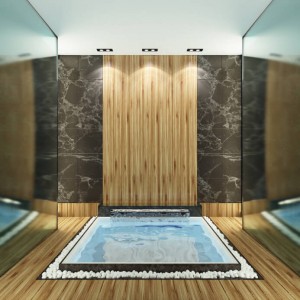Last time we dealt with the design of the spa reception. Today we make one step further, i.e. into the spa changing rooms. At first glance they may not appear to be especially important but there are a few things to keep in mind.
Hotel Spa
After having dealt already with the design of the spa’s entrance area as well as with the rooms and hallways in a spa and how they should be arranged, today we are moving forward to yet another very important room in a spa: the reception.
After dealing with the importance of the right design of the spa’s entrance area and the perspective of the guests during their stay we are today focusing on how the rooms and hallways should be laid out to your guests’ benefit.
Last time, we set off on our journey starting with the guest entering the Spa. Today, we make one step further and look at the guests’ perspective during their stay in the spa and what you can do in terms of spa interior design in order to make it as perfect as possible.
After carrying out more than 100 audits across the world I have seen very different kinds of hotel spas. We have collected my insights regarding the atmosphere in spas on our blog in a series entitled „Every inch in a Spa is Psychology“.
When entering a hotel the guest is already received in the lobby by the interior alone. In the spa, it goes even further. Here the design, the light, the materials, the fragrances and sounds fascinate, inspire and “carry away” the guest. They can downright feel the place. The composition of these stimuli does something to our minds, which goes beyond the simple joy of seeing something beautiful. In other words: A good spa with the essential spa elements can have the right to claim to be a walk-in work of art.
A spa can be simply perfect, designed by the best architects, furnished with the most elegant materials and filled with the most refined fragrances and music – in the end it’s the people in a spa that make the difference. This is why these “inner values” also belong to the personality of a spa. These values are created by the people in the spa and fill it with life. This includes employees and guests.
„The architect deals the cards.“ Many other things can subsequently be altered but hardly a building’s architecture. It defines the frame, within which the atmosphere develops. The architecture always follows a strategic concept. However, it can also be an essential part of that strategy, for example if the architecture is about achieving a unique position.
The spa architecture does not only serve optical purposes. It should also contribute to its profitability. This includes both the accents that it sets and the spatial division that strongly influences the processes in the spa. Read more
Hotels across the world usually have two basic functions: accommodation and catering. Nevertheless, most of them also excel at additional services around those “core competencies” such as events, congresses and trade fairs. A real challenge in regards to safety, hygiene and service are more exclusive areas such as the bathing, spa or fitness areas.
Spa Design is more than beauty, shapes, structures and comfortable cushions. It is about creating an environment and atmosphere that underpin the business in every respect and evoke an emotional response of your customers. A spa, assuming that it fulfils its function, has the ability to promote general relaxation and well-being.










